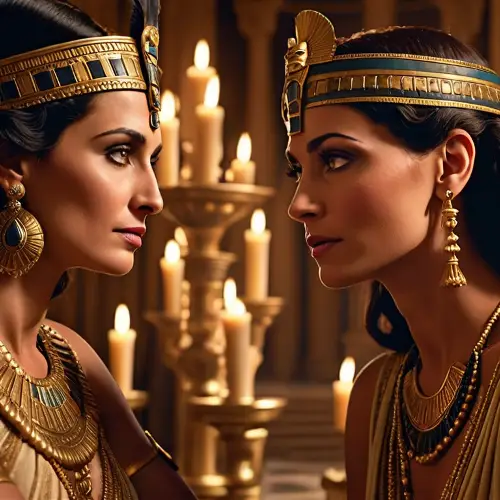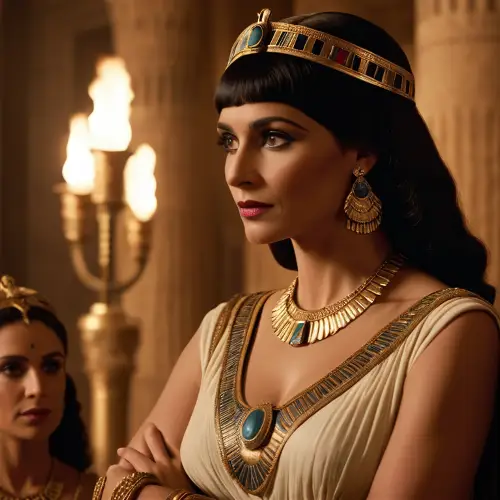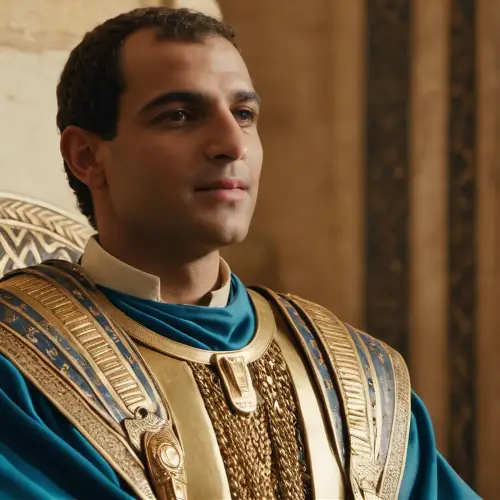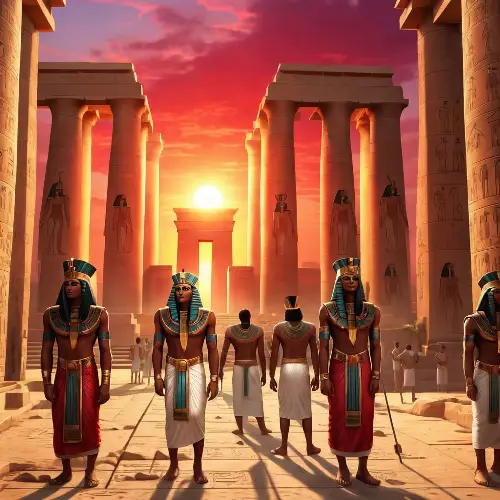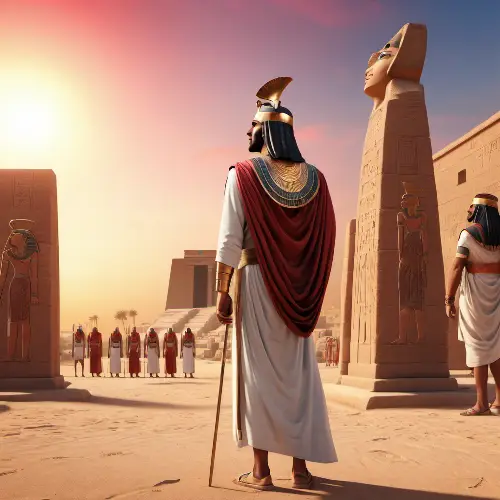On the shores of Alexandria, the grandeur of Egypt unfolds as Julius Caesar arrives. The scene is bathed in the golden hues of the sun, casting a regal glow over the monumental cityscape. The air is filled with the anticipation of an epochal encounter.Caesar, clad in the distinguished armor of a Roman general, steps onto the Egyptian soil, his presence echoing the might of Rome. The city, adorned with ancient splendor, serves as a backdrop to this pivotal moment in history. The scene captures the fusion of two formidable powers as Caesars arrival in Egypt heralds a chapter that will shape the course of empires.
More Like This
Amidst the splendor of Alexandria, Julius Caesar, the revered Roman general, finds himself captivated by the enchanting beauty of Cleopatra. The setting sun bathes the scene in warm hues as the queen, draped in regal attire, captures Caesars attention.Cleopatras allure is undeniable, her features illuminated by the fading daylight. The air is infused with a subtle tension as Caesar, entranced by her presence, succumbs to the magnetic pull of her charisma. The scene captures the moment when Cleopatras beauty casts a spell on the formidable Roman leader, setting the stage for an entwined destiny.
Against the backdrop of a serene Egyptian sunset, Cleopatra stands on the banks of the Nile, her flowing garments catching the warm hues of the evening sky. In the embrace of an opulent palace garden, adorned with lush blossoms and ancient columns, Julius Caesar approaches with an air of admiration.The air is filled with the sweet fragrance of exotic flowers, and the gentle breeze carries whispers of the Nile. Cleopatra, with a captivating smile, gazes into Caesars eyes, and the moment is frozen in time, a testament to the timeless romance between a queen and her love-struck conqueror.
In the heart of Alexandria, Julius Caesar and Cleopatra stand as central figures in a mesmerizing tableau. The opulent surroundings accentuate the magnificence of the moment, with the queens beauty and the Roman generals presence converging at the focal point.Cleopatra, draped in regal splendor, emanates an ethereal allure that captures Caesars attention. The room, adorned with the riches of Egypt, provides a sumptuous backdrop. The air is charged with a potent blend of admiration and fascination, encapsulating the captivating moment when Caesar succumbs to the enchantment of Cleopatras timeless beauty.
Against the backdrop of Cleopatras lavish palace, Julius Caesar and the queen share a moment of intimate connection. Cleopatra, draped in luxurious silks, stands with an air of regal confidence, while Caesar, in Roman attire, is visibly enchanted by her presence.They stand in a sunlit courtyard adorned with exotic flowers and ancient Egyptian sculptures. The soft rustle of palm leaves in the breeze accompanies their conversation, creating a scene where the worlds of Rome and Egypt collide in a harmonious dance of love and intellectual exchange.
Against the backdrop of Cleopatras lavish palace, Julius Caesar and the queen share a moment of intimate connection. Cleopatra, draped in luxurious silks, stands with an air of regal confidence, while Caesar, in Roman attire, is visibly enchanted by her presence.They stand in a sunlit courtyard adorned with exotic flowers and ancient Egyptian sculptures. The soft rustle of palm leaves in the breeze accompanies their conversation, creating a scene where the worlds of Rome and Egypt collide in a harmonious dance of love and intellectual exchange.
Against the backdrop of Cleopatras lavish palace, Julius Caesar and the queen share a moment of intimate connection. Cleopatra, draped in luxurious silks, stands with an air of regal confidence, while Caesar, in Roman attire, is visibly enchanted by her presence.They stand in a sunlit courtyard adorned with exotic flowers and ancient Egyptian sculptures. The soft rustle of palm leaves in the breeze accompanies their conversation, creating a scene where the worlds of Rome and Egypt collide in a harmonious dance of love and intellectual exchange.
Cleopatra and Caesar, draped in regal attire, embark on a majestic journey to Rome. Cleopatra, with a crown adorned with jewels, gracefully rides beside Caesar in a splendid chariot. The procession, rich in vibrant colors, moves through ancient landscapes as the air resonates with the sounds of cheers and fanfare. The towering architecture of Rome looms on the horizon, welcoming the powerful couple to the heart of the Roman Empire.
In the sprawling gardens of Alexandria, Marcus Antonius, from a distance, observes Cleopatra with a gaze filled with a potent mix of admiration and longing. Dressed in the regalia of a Roman general, he stands amidst the vibrant foliage, his eyes fixed on the queen.Cleopatra, unaware of his presence, is surrounded by the beauty of the botanical haven. The soft breeze carries a sense of anticipation as the scene encapsulates the silent dance of emotions between the two. The distance between them becomes a poignant canvas, portraying the complexities of a love that transcends boundaries.
In the opulent chambers of Alexandria, Cleopatra, draped in ethereal elegance, employs her magnetic charm to enchant Julius Caesar. The room, adorned with luxurious fabrics and perfumed air, becomes the clandestine theater for this seductive encounter.Cleopatras gaze, a mixture of allure and intelligence, meets Caesars with a captivating intensity. The air is thick with the heady perfume of intrigue as she skillfully weaves her charisma to captivate the Roman leader. The scene captures the enchanting moment when Cleopatra, with subtle grace, begins to unravel the threads of Caesars resolve.
In the grandeur of the Roman Senate, Julius Caesar stands amidst a circle of senators, his majestic attire contrasting with the stoic expressions of those surrounding him. The air is charged with tension as concealed daggers gleam in the dim light.As Caesar extends a trusting hand, the senators, caught in a moment of betrayal, converge upon him. The swiftness of the attack is captured by the swirling robes and startled expressions. The room echoes with the gasps of realization as the tragic scene unfolds, marking a pivotal moment in history.
In the grandeur of the Roman Senate, Julius Caesar stands amidst a circle of senators, his majestic attire contrasting with the stoic expressions of those surrounding him. The air is charged with tension as concealed daggers gleam in the dim light.As Caesar extends a trusting hand, the senators, caught in a moment of betrayal, converge upon him. The swiftness of the attack is captured by the swirling robes and startled expressions. The room echoes with the gasps of realization as the tragic scene unfolds, marking a pivotal moment in history.
Positioned on an elevated stage in the heart of Alexandria, Cleopatra stands with her back to the vast assembly of citizens, her silhouette commanding attention. The crowd, a sea of diverse faces and colorful attire, gathers in rapt anticipation, facing Cleopatra as a symbol of hope and leadership.As the queen addresses her people, the sun sets behind her, casting a warm glow on the scene. The air is filled with a sense of unity and purpose, captured by the collective gaze of the attentive citizens. Cleopatras presence, though seen from behind, emanates strength and determination, symbolizing a leader deeply connected to her people.
In the opulent chambers of Alexandria, Marcus Antonius, adorned in Roman attire, finds himself captivated by the mesmerizing allure of Cleopatra. The air is suffused with a delicate fragrance as he, with an enamored gaze, gazes upon her regal form.Cleopatra, draped in luxurious fabrics, meets Antonys eyes with a knowing smile. The room, adorned with Egyptian motifs, bears witness to the subtle dance of emotions between them. The atmosphere is charged with the undeniable chemistry of two powerful figures succumbing to the intoxicating currents of love.
Cleopatra, draped in resplendent Egyptian attire, leads a grand procession as she departs from the heart of Rome to return to Egypt. The lengthy entourage spans across the cobbled streets, adorned with Egyptian motifs and Roman architecture.Cleopatras chariot, pulled by majestic horses, takes the forefront, followed by a colorful array of courtiers, soldiers, and exotic animals. The air is filled with the sounds of celebratory music, and banners flutter in the wind. The procession weaves through the bustling streets, leaving a trail of awe and wonder in its wake, symbolizing the union of two powerful empires.
Against the backdrop of the Egyptian desert, Cleopatra and Marcus Antonius stand atop a cliff, silhouetted against the breathtaking hues of a setting sun. The sky is ablaze with warm tones of orange and pink, casting a romantic glow on the lovers.Cleopatras flowing garments catch the gentle breeze as Antony, with a tender embrace, gazes into her eyes. The sands below them reflect the rich palette of the evening sky. The moment captures a timeless love, set against the canvas of a mesmerizing sunset, where the world seems to pause, allowing the beauty of their connection to unfold.
Against the backdrop of the Egyptian desert, Cleopatra and Marcus Antonius stand atop a cliff, silhouetted against the breathtaking hues of a setting sun. The sky is ablaze with warm tones of orange and pink, casting a romantic glow on the lovers.Cleopatras flowing garments catch the gentle breeze as Antony, with a tender embrace, gazes into her eyes. The sands below them reflect the rich palette of the evening sky. The moment captures a timeless love, set against the canvas of a mesmerizing sunset, where the world seems to pause, allowing the beauty of their connection to unfold.
In the opulent halls of Cleopatras palace, Julius Caesar, captivated by the queens enchanting beauty and wisdom, gazes into her eyes with a mixture of admiration and affection. Cleopatra, adorned in resplendent attire, exudes an air of regal grace.The room is bathed in the warm glow of flickering torches, casting a romantic ambiance. As Cleopatra imparts words of wisdom, Caesar listens with rapt attention. The scene captures the intersection of love and intellectual connection, with both figures illuminated against the backdrop of a grand chamber adorned with Egyptian motifs.
Standing atop a grand podium in the heart of Alexandria, Cleopatra, regal and poised, addresses her people with eloquence. The sprawling crowd gathers in awe, draped in vibrant fabrics that mirror the diverse tapestry of ancient Egypt.The sun sets, casting a warm glow on Cleopatra as she speaks, emphasizing her commitment to unity and progress. Banners bearing symbols of prosperity flutter in the breeze, and the air is filled with the anticipation of positive change. The scene captures a moment of collective inspiration as Cleopatra, with charisma and authority, articulates her vision for a flourishing and harmonious Egypt.
In a dramatic turn of events, the scene unfolds as Julius Caesar, adorned in the regal garments of his time, stands surrounded by Roman senators. The atmosphere is tense in the Senate chamber, and a sense of betrayal lingers in the air. As Caesar reaches out, a sudden and treacherous act unfolds—the senators converge, and the daggers are unsheathed.The dimly lit room witnesses the shocking act of betrayal, capturing the intensity of the moment. Caesars expression reflects both surprise and defiance as the conspiracy unfolds around him.
In a dramatic turn of events, the scene unfolds as Julius Caesar, adorned in the regal garments of his time, stands surrounded by Roman senators. The atmosphere is tense in the Senate chamber, and a sense of betrayal lingers in the air. As Caesar reaches out, a sudden and treacherous act unfolds—the senators converge, and the daggers are unsheathed.The dimly lit room witnesses the shocking act of betrayal, capturing the intensity of the moment. Caesars expression reflects both surprise and defiance as the conspiracy unfolds around him.
Following the fateful assassination of Julius Caesar, Cleopatra, draped in mourning attire, retreats to the embrace of Egypt. The journey back to Alexandria is fraught with a mix of grief and strategic contemplation, with the queen navigating the complex aftermath of Caesars demise.Cleopatras countenance, a blend of sorrow and determination, reflects the weight of the political landscape. The air is heavy with the echoes of shifting alliances as she returns to Egypt, her steps marked by the indelible impact of Caesars assassination. The scene captures the queens poignant return, as she grapples with the repercussions of a world forever altered.
In the opulent halls of Cleopatras palace, a momentous occasion unfolds as Cleopatra, radiant in regal attire, stands before a gathered assembly. Her son, Caesarion, stands beside her, the embodiment of a future ruler.Cleopatra, with a proud and loving expression, places a golden crown on Caesarions head, symbolizing his ascent to power. The courtiers and nobles look on with reverence and anticipation. The room is adorned with rich tapestries and intricate Egyptian motifs, echoing the grandeur of the occasion as the young ruler assumes his role under the watchful guidance of his queen mother.
Cleopatra is seated at the center, elegantly poised, with Caesar on one side and Antony on the other. Cleopatra sits gracefully, Caesar stands with authority, and Antony gazes at her passionately. Their attire reflects their origins and status, and the background harmoniously combines elements from both Rome and Egypt, symbolizing the intricate relationships of love and politics among them.
In the golden halls of Alexandria, Cleopatra, adorned in royal garments, solemnly presents her 3-year-old son, Caesarion, as the co-ruler Pharaoh Ptolemy XV. The room, adorned with symbols of Egyptian majesty, becomes the stage for a pivotal moment in history.Cleopatras face reflects a mix of maternal tenderness and regal authority as she places the diadem on the young Caesarions head. The air is charged with the promise of a new era as mother and son, in a poignant tableau, embody the continuity of Egypts lineage. The scene captures the essence of a queen securing her sons legacy and entrusting him with the weighty mantle of rulership.
In the golden halls of Alexandria, Cleopatra, adorned in royal garments, solemnly presents her 3-year-old son, Caesarion, as the co-ruler Pharaoh Ptolemy XV. The room, adorned with symbols of Egyptian majesty, becomes the stage for a pivotal moment in history.Cleopatras face reflects a mix of maternal tenderness and regal authority as she places the diadem on the young Caesarions head. The air is charged with the promise of a new era as mother and son, in a poignant tableau, embody the continuity of Egypts lineage. The scene captures the essence of a queen securing her sons legacy and entrusting him with the weighty mantle of rulership.
In the golden halls of Alexandria, Cleopatra, adorned in royal garments, solemnly presents her 3-year-old son, Caesarion, as the co-ruler Pharaoh Ptolemy XV. The room, adorned with symbols of Egyptian majesty, becomes the stage for a pivotal moment in history.Cleopatras face reflects a mix of maternal tenderness and regal authority as she places the diadem on the young Caesarions head. The air is charged with the promise of a new era as mother and son, in a poignant tableau, embody the continuity of Egypts lineage. The scene captures the essence of a queen securing her sons legacy and entrusting him with the weighty mantle of rulership.
In the private chambers of Alexandria, the back view of Marcus Antonius in his early thirties unfolds as he stands at a discreet distance, silently observing Cleopatra. The room is adorned with luxurious Egyptian decor, creating an intimate and captivating atmosphere.Antony, dressed in the distinguished attire of a Roman statesman, exudes a sense of contemplation. His posture reflects a mixture of admiration and introspection as he takes in the regal presence of Cleopatra. The scene freezes this moment, capturing the quiet intensity of Antonys emotions from behind.
In the private chambers of Alexandria, the back view of Marcus Antonius in his early thirties unfolds as he stands at a discreet distance, silently observing Cleopatra. The room is adorned with luxurious Egyptian decor, creating an intimate and captivating atmosphere.Antony, dressed in the distinguished attire of a Roman statesman, exudes a sense of contemplation. His posture reflects a mixture of admiration and introspection as he takes in the regal presence of Cleopatra. The scene freezes this moment, capturing the quiet intensity of Antonys emotions from behind.
In the private chambers of Alexandria, the back view of Marcus Antonius in his early thirties unfolds as he stands at a discreet distance, silently observing Cleopatra. The room is adorned with luxurious Egyptian decor, creating an intimate and captivating atmosphere.Antony, dressed in the distinguished attire of a Roman statesman, exudes a sense of contemplation. His posture reflects a mixture of admiration and introspection as he takes in the regal presence of Cleopatra. The scene freezes this moment, capturing the quiet intensity of Antonys emotions from behind.
In the private chambers of Alexandria, the back view of Marcus Antonius in his early thirties unfolds as he stands at a discreet distance, silently observing Cleopatra. The room is adorned with luxurious Egyptian decor, creating an intimate and captivating atmosphere.Antony, dressed in the distinguished attire of a Roman statesman, exudes a sense of contemplation. His posture reflects a mixture of admiration and introspection as he takes in the regal presence of Cleopatra. The scene freezes this moment, capturing the quiet intensity of Antonys emotions from behind.
In the vibrant spring of 51 BCE, bathed in the warm glow of sunlight, the young Ptolemy XIII assumes his fathers mantle as the Pharaoh of Egypt. His face, a mixture of youthful innocence and the weight of responsibility, reveals the essence of a burgeoning leader.Seated beside him on the throne, Cleopatra, his sister and co-ruler, the epitome of regal grace, signifies unity and strength. Their marriage becomes a symbol of power and consolidation, promising to guide Egypts destiny hand in hand. The scene encapsulates the tender moment of an alliance, where two hearts, still in their formative years, pledge to grow together.
Cleopatra’s journey unfolding in the golden-hued expanse of the desert
In the opulent chambers of Cleopatras palace, Marcus Antonius, clad in Roman attire, presents a meticulously drawn map of selected regions to Cleopatra. The room is adorned with symbols of both Egypt and Rome, signifying the union of their empires.Antony, with a gesture of respect, offers the map to Cleopatra, highlighting the areas marked for her dominion. The map unfolds to reveal the intricate details of the gifted territories. The scene captures a moment of diplomatic exchange, symbolizing the complex interplay of power and love between two influential figures of the ancient world.
In the grandeur of Alexandria, Cleopatra, now 18 years old, stands poised on the precipice of her reign. Adorned in regal attire that blends Egyptian and Hellenistic influences, she exudes an air of confidence and grace beyond her years.The room, rich with symbols of power, bears witness to Cleopatras maturation into a formidable leader. Her eyes, a reflection of wisdom and determination, hint at the challenges and triumphs that lie ahead. The scene captures the young queen on the cusp of her rule, ready to navigate the complexities of governance with both strength and sophistication.
Ancient Egypt. People in local dress. The man stands determinedly, looking towards the land with his loyal men and women standing next to him. The rising sun casts a crimson hue over the Temple of Horus. realistic image. high detail. 8K image
Cleopatra, adorned in regal attire, cradles her newborn son, Caesarion, in her arms. The room is bathed in a soft, golden glow from flickering candles, casting a warm ambiance. Caesar, with a proud and tender expression, stands by Cleopatras side, witnessing the arrival of their heir. The air is filled with a sense of anticipation and joy as they welcome the newest member of their royal family.
In the resplendent halls of Alexandria, Cleopatra, adorned in regal attire, ascends the throne alongside her son, Ptolemy XV Philopator Philometor Caesarion, a mere thirteen years old. The room, adorned with opulent Egyptian decor, bears witness to the historic moment of succession.Cleopatras face reflects a blend of maternal pride and sovereign determination as she places the diadem on her young sons head. The air is charged with a sense of continuity and the promise of a new era as Cleopatra, with graceful authority, establishes her son as the heir to the throne. The scene captures the essence of a queen securing the legacy of her lineage.
Cleopatra, adorned in regal attire, walks through a bustling construction site in the heart of Alexandria. Surrounded by architects and craftsmen, she inspects the progress of a grand edifice taking shape. Dust fills the air as skilled artisans meticulously carve intricate details into stone, bringing her architectural vision to life.The backdrop is a blend of ancient Egyptian motifs and Hellenistic design, reflecting Cleopatras commitment to a harmonious synthesis. The rhythmic sounds of construction echo through the air, and the queen, with a keen eye, offers guidance to ensure the realization of her ambitious architectural endeavor.
Against the backdrop of Roman opulence, Cleopatra, adorned in resplendent Egyptian attire, engages in a diplomatic dance within the aristocratic circles of Rome. The grand halls echo with the cadence of political discourse as she navigates the complex world of Roman nobility.Cleopatras presence, a fusion of regality and exotic charm, captures the attention of Roman dignitaries. The air is filled with the delicate interplay of diplomacy and intrigue, as the queen strategically forges alliances and cements her influence amidst the marble statues and tapestries of Rome. The scene encapsulates Cleopatras deft maneuvering through the aristocratic tapestry of the Roman elite.
In the grandeur of the Roman Senate, Julius Caesar, draped in regal attire, stands unaware of the conspiratorial shadows that encircle him. The senators, cloaked in treachery, close in with daggers concealed beneath their garments.The air is thick with tension as the betrayal unfolds, and Caesar, in a moment of realization, is met with a cascade of lethal blows. The room echoes with the muffled sounds of a struggle, the grandeur of power extinguished in the brutality of political betrayal. The scene captures the tragic climax of the Ides of March, marking the fall of a mighty leader at the hands of those he once trusted.
In the heart of Alexandria, Cleopatra stands amidst a construction site, adorned in regal attire with architectural plans in hand. Skilled artisans and builders, inspired by her vision, work tirelessly on monumental structures that blend Egyptian and Hellenistic influences.The air resonates with the sounds of chisels and hammers against stone, creating a symphony of progress. Columns rise, adorned with intricate carvings, and grand archways take shape, symbolizing the synthesis of cultures under Cleopatras reign. The scene captures the queens commitment to architectural innovation, as ancient and contemporary elements come together to shape a new era for Egypt.




































